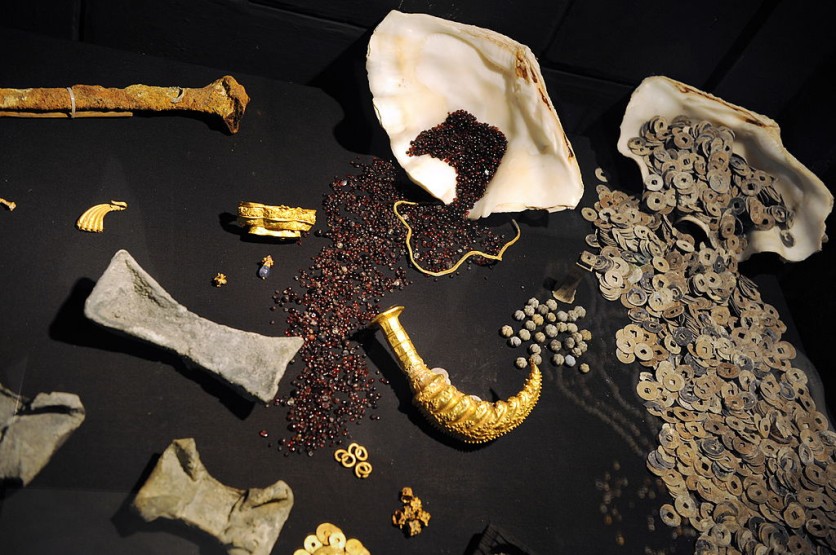Archaeologists from Oregon State University claim that they discovered projectile points in Idaho that are thousands of years older than any that have been discovered in the Americas.
This remarkable find may help fill in the historical gaps of how the earliest humans made and utilized stone weapons.

(Photo : ROMEO GACAD/AFP via Getty Images)
TO GO WITH INDONESIA-ARCHAEOLOGY-CHINA-BELGIUM, FEATURE BY STEPHEN COATES Ancient gold handle of a dagger (below center) with an arabic inscription is displayed together with other gold jewelries, garnet stones on a shell and other precious items at a showroom in south Jakarta on April 30, 2010.
15,700 Year- Projectile Points
According to carbon-14 dating, the 13 complete and broken projectile points, which range from half an inch to two inches, date to a time around 15,700 years ago.
This is 2,300 years earlier than the points that were discovered in the past at the same Cooper's Ferry location along the Salmon River in modern-day Idaho, and roughly 3,000 years older than the Clovis fluted points found across North America.
However, according to the team's chief Loren Davis, the unearthing of projectile points offers fresh insights into how the early Americans articulated sophisticated ideas through technology at that time.
The points were discovered near the Salmon River, which is on traditional Nez Perce territory and is known to the tribe as the site of the former settlement of Nipéhe. The federal Bureau of Land Management currently owns the land.
According to Davis, the points' age and likeness to projectile points discovered in Japan's Hokkaido island between 16,000 and 20,000 years ago are not the only things that make them revelatory.
Read Also : Turkish Man Breaks Basement Wall, Uncovers an Ancient Underground City that Sheltered 20,000 People
"Revelatory"
According to Davis, the points' age and likeness to projectile points discovered in Japan's Hokkaido island between 16,000 and 20,000 years ago are not the only things that make them revelatory.
The idea that the ice period inhabitants of Northeast Asia and North America shared early genetic and cultural ties is strengthened by their presence in Idaho.
"The earliest peoples of North America possessed cultural knowledge that they used to survive and thrive over time. Some of this knowledge can be seen in the way people made stone tools, such as the projectile points found at the Cooper's Ferry site," Davis said in a statement.
Davis notes that by contrasting these spots with sites that are similar in age or older, it is possible to determine the spatial extents of the social networks where this technological information was distributed among early humans.
According to Davis, by contrasting these spots with sites that are similar in age or older, it is possible to determine the spatial extents of the social networks where this technological information was distributed among early humans.
Despite their diminutive size, they were devastating weapons, according to Davis, and they were probably tied to darts rather than arrows or spears.
The recently discovered pits are a part of the larger Cooper's Ferry record, which also includes a fire pit that dates back 14,200 years and a food-processing area with the relics of an extinct horse, both of which were previously reported by Davis and his team.
More than 65,000 artifacts were discovered and mapped, with exact millimeter-level documentation of their placements.
The full findings of the team are published in the journal Science Advances.
Related Article : Archaeologists Find Ancient Stone Engravings that May Have Been the Earliest Form of Animation

ⓒ 2025 TECHTIMES.com All rights reserved. Do not reproduce without permission.




